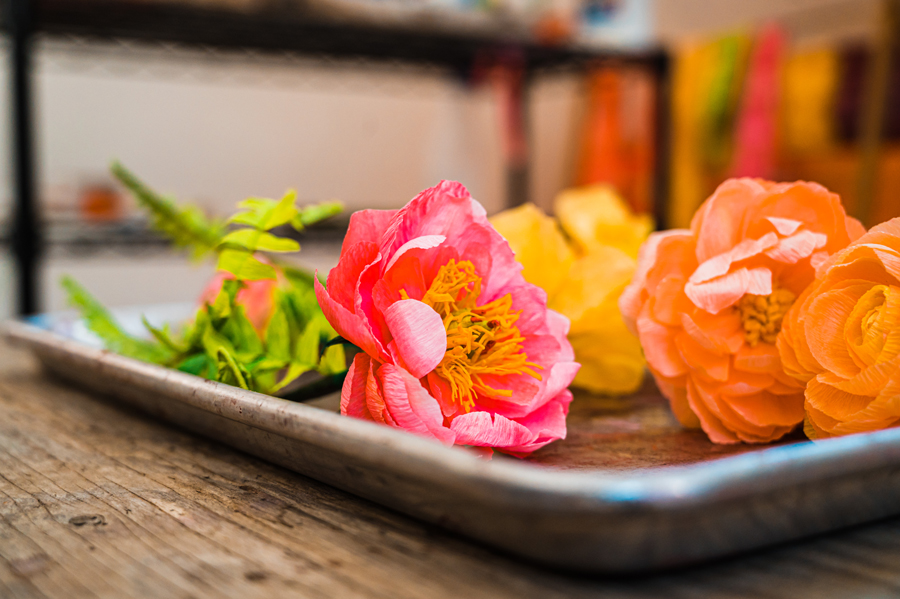By Jesse Ellison
Photographed by Tory Welton
Amity Katharine Libby’s discovery of botanical realism came out of a time and feeling that may seem familiar in the spring of 2021: intense isolation. It was January 2016, and she was unexpectedly pregnant and newly unemployed, at home full-time but not by choice. She’d just finished a long-term, grant-funded gig at the Coastal Maine Botanical Gardens, where she worked under a botanist, designing curricula for middle schools across the state. Sitting at home, scrolling through Instagram, she stumbled upon a whole new medium: flowers made of paper. “It immediately ticked off all these boxes in my brain,” she says. “For like $20, I had paper and glue and wires. From there, it was just on — my hands were busy. For me, like this meditative manipulation of paper, when everything is cold and gray and white? It just transformed that winter.”





Libby’s attention to detail extends to every part of a flower’s anatomy.
Five years later, Libby’s intricate paper flower sculptures in custom ceramic holders can be found on display at the Botanical Gardens’ annual Gardens Aglow and for sale at the Good Supply, in Bristol, where one bouquet — called “the Celine” and comprised of roses, chrysanthemums, winter berries on branches, and ferns — is priced at $1,650. But she says her real bread and butter is teaching: creating workshops, tutorials, and written guides for would-be botanical realists, both in person and online. In 2020, through her teaching studio, Flower and Jane, she worked with four other botanical realists — all women, in places as far-flung as Melbourne and as close as Brooklyn — to create a four-part curriculum: Shasta daisy, Shirley poppy, meadow buttercup, and hydrangea. Once students take all four classes, they receive a certificate in botanical realism. Each class costs $55. Within 100 days of launching, Libby and her cohorts had grossed $13,000. Given the pandemic, the popularity of the courses didn’t come as a surprise.
“People definitely needed an escape route,” Libby says. “It shouldn’t be drugs; it shouldn’t be costly. You need a place to sail away? Well, have I got the place for you.”
Tell Us More Amity Libby

So what is botanical realism?
It’s all about tricking the eye, so you can’t tell if it’s real or not. It’s about texture, color, and aberration. One thing I can catch with someone is if it’s too perfect. Things should have insects or discoloration or something — that’s part of realism. What are the essential elements that trick the eye? For each flower it’s different. If you have a straight-stemmed poppy, you’re not paying attention. Most flowers look like they’re dancing. Nature knows what’s going on, you have to figure out how to translate it.
I imagine it forces you to really examine flowers incredibly closely.
The year I started, that March, I got a daffodil and I deconstructed it. I physically pulled it apart and traced the shapes and measured them, said okay, what is this? This is a corona, this is a stamen. This stuff is all important. It just crystalized it for me — this is why the plant is so pretty. Many times, I won’t make a flower until I have grown it. This year, I have this crazy carnation — a dancing geisha. It looks like this bizarre thing. I’m like, “Okay, if I can get this thing to bloom, I can make it in paper.”
Is it hard to work in winter, with so little greenery to look to for inspiration?
I actually do better work when it’s snowing and storming out. My studio I share as a playroom with my daughter, and I’m like, “Let’s go upstairs and make a huge mess.” Coloring is the most fun part — transforming a flat color. Mother Nature is never flat. I take Italian crepe paper and dip it in water or give it an overnight bath, playing with color and coloration. You lose yourself. On these gray, cold, frigid days, I can go upstairs and see if my paper’s dry. It’s the best.

Are there any flowers you can’t, or won’t, make from paper?
People always ask me for lupines. There will be no lupines. They’re all petals. It’d be like a thousand-dollar flower. No. The fewer the petals, the better we are.
To learn more about Amity and company’s botanical realism courses, visit flowerandjane.com. See more of Flower and Jane’s work at thegoodsupply.org.



